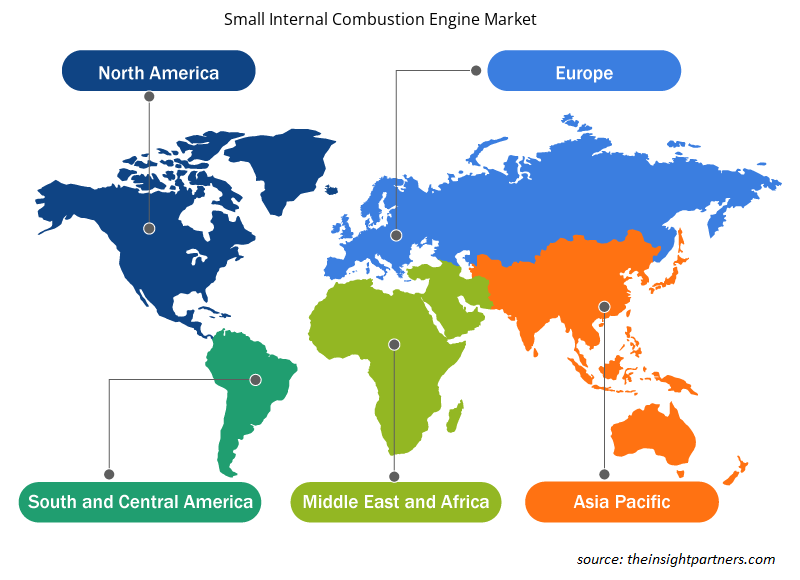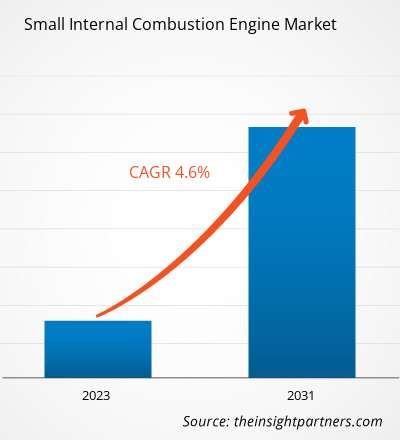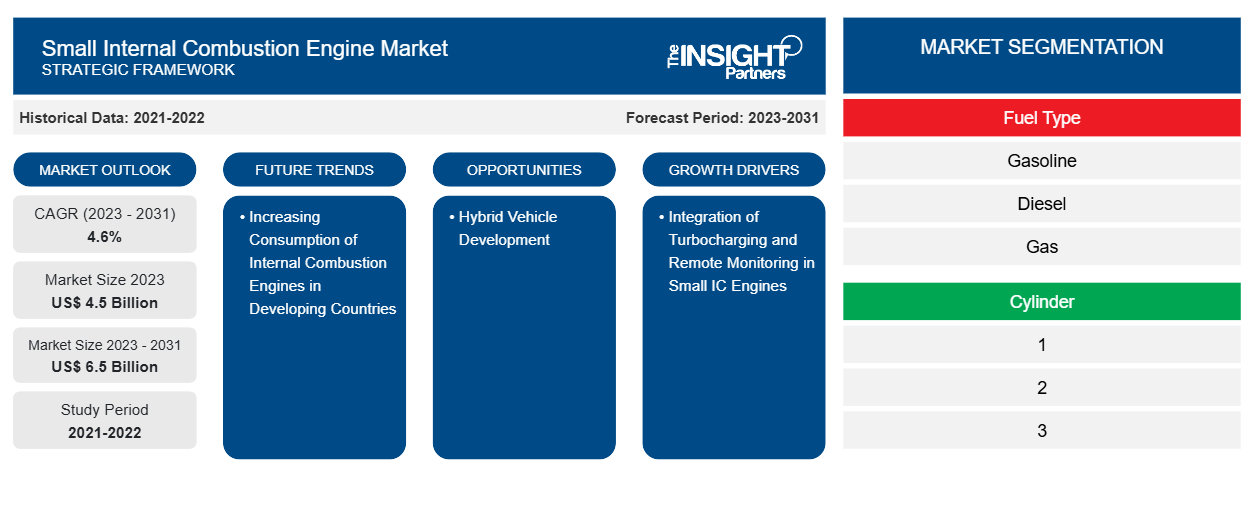Si prevede che il mercato dei piccoli motori a combustione interna raggiungerà i 6,5 miliardi di dollari entro il 2031, rispetto ai 4,5 miliardi di dollari del 2023. Si prevede che il mercato crescerà registrando un CAGR del 4,6% nel 2023-2031. La crescente adozione di piccoli motori a combustione interna in applicazioni agricole, residenziali e di edilizia sta alimentando la crescita del mercato globale dei piccoli motori a combustione interna.
Analisi di mercato dei piccoli motori a combustione interna
La crescente domanda di motori a basso consumo di carburante e a basse emissioni inquinanti per ridurre la quantità di inquinamento atmosferico sta spingendo la crescita del mercato. L'emergere di motori elettrici nei trasporti, nell'automotive e in altre applicazioni industriali nel mercato globale è uno dei fattori difficili che ostacolano la crescita del mercato. Sebbene si tratti di piccoli motori a combustione interna, c'è ancora un'opportunità per sostenere la crescita relativa alla sua migliore efficienza del carburante. La crescente domanda di miniaturizzazione delle apparecchiature di potenza per ottimizzare lo spazio e il design viene soddisfatta con piccoli motori a combustione interna.
Panoramica del mercato dei piccoli motori a combustione interna
La potenza generata dai piccoli motori a combustione interna (IC) avviene tramite vari tipi di carburanti, come diesel, benzina e gas. Ogni carburante ha un insieme specifico di proprietà, come densità e volatilità, che derivano il suo utilizzo nell'applicazione richiesta. I motori diesel sono preferiti per applicazioni pesanti o dove il fabbisogno di potenza è elevato. Al contrario, i piccoli motori IC a benzina sono meno dannosi per l'ambiente in quanto producono basse emissioni rispetto ad altri. L'uso del gas naturale nella tecnologia di combustione dei piccoli motori ha il potenziale per risolvere i problemi di elevate emissioni e aiuterà i produttori a soddisfare le nuove norme normative. C'è un aumento nell'adozione di piccoli motori a combustione interna (IC) in Sud America, Asia e Africa, mentre Nord America ed Europa si sposteranno verso i motori elettrici durante il periodo di previsione.
Personalizza questo report in base alle tue esigenze
Riceverai la personalizzazione gratuita di qualsiasi report, comprese parti di questo report, o analisi a livello nazionale, pacchetto dati Excel, oltre a usufruire di grandi offerte e sconti per start-up e università
-
Scopri le principali tendenze di mercato in questo rapporto.Questo campione GRATUITO includerà analisi di dati che spaziano dalle tendenze di mercato alle stime e alle previsioni.
Driver e opportunità del mercato dei piccoli motori a combustione interna
Aumento del consumo di motori a combustione interna nei paesi in via di sviluppo
I paesi in via di sviluppo, tra cui India, Cina, Corea del Sud e Brasile, dipendono maggiormente dai combustibili fossili per la generazione di elettricità, l'automotive, la produzione, i trasporti e altri settori. La popolazione in crescita e la mancanza di sviluppo infrastrutturale per le tecnologie elettriche sono i principali fattori che supportano il mercato dei piccoli motori a combustione interna. I motori elettrici, i dispositivi alimentati da energia elettrica e le auto sono ancora più costosi per i clienti rispetto ai motori a combustione interna. Di conseguenza, a causa dei vincoli di prezzo, i paesi non stanno implementando alcun divieto sui motori a combustione interna, il che sta supportando la crescita del mercato.
Le norme sulle emissioni stanno migliorando per i piccoli motori IC per i quali i produttori stanno potenziando la soluzione. Secondo i dati del World Bank Group per l'accesso all'elettricità, nell'Asia meridionale, circa il 91,6% della popolazione ha accesso all'elettricità. Inoltre, il consumo di elettricità per usi di base in paesi come Cina e India sta aumentando con l'aumento della popolazione, per cui i paesi stanno utilizzando combustibili fossili per la generazione di elettricità. Si prevede che tale forte predominio dei motori a combustione interna (IC) nelle regioni in via di sviluppo creerà un'opportunità per il mercato dei piccoli motori a combustione interna di offrire soluzioni avanzate. Ad esempio, secondo la società Bosch Ltd, oltre l'80% dei veicoli venduti in India entro il 2030 sarà alimentato da motori a combustione interna (IC). La dipendenza delle regioni in via di sviluppo dai combustibili fossili e dai motori a combustione interna (IC) è una forte opportunità di crescita per il mercato dei piccoli motori IC.
Integrazione di turbocompressione e monitoraggio remoto nei piccoli motori a combustione interna
La tecnologia di turbocompressione è già utilizzata nei motori a combustione interna (IC) dei veicoli automobilistici per aumentare la capacità di potenza dei motori di media potenza. Le piccole aziende produttrici di motori a combustione interna stanno studiando l'adozione della tecnologia di turbocompressione, in particolare i requisiti dei piccoli motori. Si prevede che la tecnologia di turbocompressione verrà introdotta per pompe idrauliche, risciò, tosaerba, attrezzature per giardinaggio, generatori e trattori durante il periodo di previsione. Si suppone che la tecnologia di turbocompressione fornisca una potenza specifica in uscita maggiore del 40-60% nei motori di cilindrata inferiore. Si prevede che tale integrazione di turbocompressori nei piccoli motori IC creerà una nuova tendenza per il mercato nei prossimi anni.
Inoltre, con la crescente digitalizzazione in quasi ogni settore verticale, anche il mercato dei piccoli motori a combustione interna si sta evolvendo con la connettività digitale. Ad esempio, Briggs & Stratton, LLC offre un generatore Elite Series da 8 kW con connettività Bluetooth e monitoraggio remoto tramite cellulare. È dotato della tecnologia InfoHub Portable Power, che fornisce il monitoraggio remoto dei generatori portatili dotati di piccoli motori a combustione interna. Tali opzioni di connettività migliorano l'interfaccia utente e macchina, il che potrebbe creare una nuova tendenza nel mercato.
Analisi della segmentazione del rapporto di mercato dei piccoli motori a combustione interna
I segmenti chiave che hanno contribuito alla derivazione dell'analisi di mercato dei piccoli motori a combustione interna sono carburante, cilindro, potenza in uscita e utente finale.
- In base al tipo di carburante, il mercato dei piccoli motori a combustione interna è stato suddiviso in benzina, diesel, gas (CNG, GPL, LNG). Il segmento benzina ha detenuto una quota di mercato maggiore nel 2023.
- In base al cilindro, il mercato dei piccoli motori a combustione interna è stato suddiviso in 1, 2, 3 e 4. Il segmento a 1 cilindro ha detenuto una quota di mercato maggiore nel 2023.
- Sulla base della potenza in uscita, il mercato è stato segmentato in 1-5 kW, 6-10 kW, 11-20 kW. Il segmento 11-20 kW ha dominato il mercato nel 2023.
- In base all'utente finale, il mercato è stato suddiviso in generazione di energia, produzione, petrolio e gas, trasporti e altri. Il segmento dei trasporti ha detenuto una quota di mercato maggiore nel 2023.
Analisi della quota di mercato dei piccoli motori a combustione interna per area geografica
L'ambito geografico del rapporto sul mercato dei piccoli motori a combustione interna è suddiviso principalmente in cinque regioni: Nord America, Europa, Asia Pacifico, Medio Oriente e Africa e Sud America.
L'Asia Pacifica dominerà il mercato dei piccoli motori a combustione interna nel 2023. India e Cina sono i principali paesi produttori di motori a combustione interna nell'Asia Pacifica. L'aumento del reddito disponibile nei paesi in via di sviluppo, in particolare in India e Cina, sta portando a un'ampia base di clienti per piccoli motori a combustione interna, come generatori di corrente, motori industriali, veicoli a due ruote e utensili elettrici, che sta guidando la crescita del mercato dei piccoli motori a combustione interna. La Cina è un importante polo produttivo per motori a combustione interna, mentre India e Giappone sono anche considerati importanti contributori alla crescita regionale.
Vari paesi APAC sono caratterizzati dalla produzione di massa di piccoli motori IC necessari per la produzione, la generazione di energia e altri macchinari industriali . Il crescente numero di aziende manifatturiere in India e Cina, dovuto alla forte disponibilità di risorse umane qualificate, sta guidando la crescita del mercato dei piccoli motori a combustione interna. Un aumento delle vendite di veicoli a due ruote e il progresso nelle fonti di carburante per motori supportano la crescita del mercato. Inoltre, a causa della popolazione in crescita nella regione e delle capacità economiche relativamente basse di varie nazioni, è stata promossa l'adozione di motori IC piuttosto che di energia elettrica.
Approfondimenti regionali sul mercato dei piccoli motori a combustione interna
Le tendenze regionali e i fattori che influenzano il mercato dei piccoli motori a combustione interna durante il periodo di previsione sono stati ampiamente spiegati dagli analisti di Insight Partners. Questa sezione discute anche i segmenti e la geografia del mercato dei piccoli motori a combustione interna in Nord America, Europa, Asia Pacifico, Medio Oriente e Africa e America meridionale e centrale.

- Ottieni i dati specifici regionali per il mercato dei piccoli motori a combustione interna
Ambito del rapporto di mercato sui piccoli motori a combustione interna
| Attributo del report | Dettagli |
|---|---|
| Dimensioni del mercato nel 2023 | 4,5 miliardi di dollari USA |
| Dimensioni del mercato entro il 2031 | 6,5 miliardi di dollari USA |
| CAGR globale (2023-2031) | 4,6% |
| Dati storici | 2021-2022 |
| Periodo di previsione | 2023-2031 |
| Segmenti coperti |
Per tipo di carburante
|
| Regioni e Paesi coperti |
America del Nord
|
| Leader di mercato e profili aziendali chiave |
|
Densità dei piccoli attori del mercato dei motori a combustione interna: comprendere il suo impatto sulle dinamiche aziendali
Il mercato dei motori a combustione interna di piccole dimensioni sta crescendo rapidamente, spinto dalla crescente domanda degli utenti finali dovuta a fattori quali l'evoluzione delle preferenze dei consumatori, i progressi tecnologici e una maggiore consapevolezza dei vantaggi del prodotto. Con l'aumento della domanda, le aziende stanno ampliando le loro offerte, innovando per soddisfare le esigenze dei consumatori e capitalizzando sulle tendenze emergenti, il che alimenta ulteriormente la crescita del mercato.
La densità degli operatori di mercato si riferisce alla distribuzione di aziende o società che operano in un particolare mercato o settore. Indica quanti concorrenti (operatori di mercato) sono presenti in un dato spazio di mercato in relazione alle sue dimensioni o al valore di mercato totale.
Le principali aziende che operano nel mercato dei piccoli motori a combustione interna sono:
- Caterpillar Inc
- Kawasaki Heavy Industries Ltd
- Mitsubishi Heavy Industries Ltd
- Liebherr
- Società per azioni Yanmar Holdings Co.
- Società anonima
Disclaimer : le aziende elencate sopra non sono classificate secondo un ordine particolare.

- Ottieni una panoramica dei principali attori del mercato dei piccoli motori a combustione interna
Notizie e sviluppi recenti sul mercato dei piccoli motori a combustione interna
Il mercato dei piccoli motori a combustione interna viene valutato raccogliendo dati qualitativi e quantitativi dopo la ricerca primaria e secondaria, che include importanti pubblicazioni aziendali, dati associativi e database. Di seguito è riportato un elenco degli sviluppi nel mercato dei piccoli motori a combustione interna e delle strategie:
- A marzo 2023, Tata Cummins Green Energy Solutions ha fondato uno stabilimento di produzione di motori ICE a idrogeno per veicoli commerciali medi e pesanti. Questa struttura rafforzerà la posizione e la presenza dell'azienda nel mercato indiano.
- Nel gennaio 2021, Caterpillar Marine ha firmato un accordo per la fornitura di motori marini per la nuova flotta di sei rimorchiatori della classe YT 808 della Marina degli Stati Uniti.
Copertura e risultati del rapporto di mercato sui piccoli motori a combustione interna
Il rapporto "Dimensioni e previsioni del mercato dei piccoli motori a combustione interna (2021-2031)" fornisce un'analisi dettagliata del mercato che copre le seguenti aree:
- Dimensioni e previsioni del mercato a livello globale, regionale e nazionale per tutti i segmenti di mercato chiave coperti dall'ambito
- Dinamiche di mercato come fattori trainanti, vincoli e opportunità chiave
- Principali tendenze future
- Analisi dettagliata delle cinque forze di Porter
- Analisi di mercato globale e regionale che copre le principali tendenze di mercato, i principali attori, le normative e gli sviluppi recenti del mercato
- Analisi del panorama industriale e della concorrenza che copre la concentrazione del mercato, l'analisi della mappa di calore, i principali attori e gli sviluppi recenti
- Profili aziendali dettagliati con analisi SWOT
- Analisi storica (2 anni), anno base, previsione (7 anni) con CAGR
- Analisi PEST e SWOT
- Valore/volume delle dimensioni del mercato - Globale, Regionale, Nazionale
- Industria e panorama competitivo
- Set di dati Excel
Report recenti
Testimonianze
Motivo dell'acquisto
- Processo decisionale informato
- Comprensione delle dinamiche di mercato
- Analisi competitiva
- Analisi dei clienti
- Previsioni di mercato
- Mitigazione del rischio
- Pianificazione strategica
- Giustificazione degli investimenti
- Identificazione dei mercati emergenti
- Miglioramento delle strategie di marketing
- Aumento dell'efficienza operativa
- Allineamento alle tendenze normative























 Ottieni un campione gratuito per - Mercato dei piccoli motori a combustione interna
Ottieni un campione gratuito per - Mercato dei piccoli motori a combustione interna